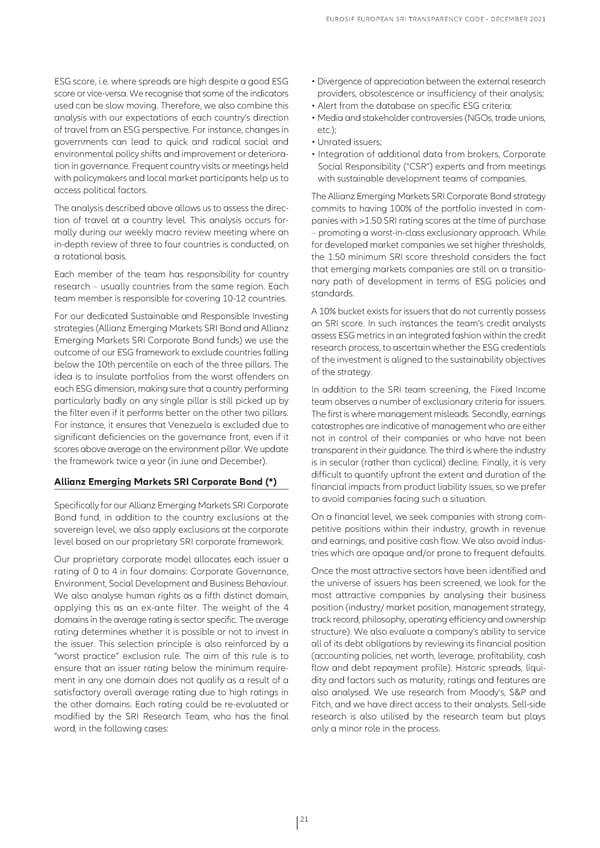EuRoSIf EuRopEaN SRI TRaNSpaRENcy coDE - DEcEmbER 2021 ESG score, i.e. where spreads are high despite a good ESG • Divergence of appreciation between the external research score or vice-versa. We recognise that some of the indicators providers, obsolescence or insufficiency of their analysis; used can be slow moving. Therefore, we also combine this • alert from the database on specific ESG criteria; analysis with our expectations of each country’s direction • media and stakeholder controversies (NGos, trade unions, of travel from an ESG perspective. for instance, changes in etc.); governments can lead to quick and radical social and • unrated issuers; environmental policy shifts and improvement or deteriora- • Integration of additional data from brokers, corporate tion in governance. frequent country visits or meetings held Social Responsibility (“cSR”) experts and from meetings with policymakers and local market participants help us to with sustainable development teams of companies. access political factors. The allianz Emerging markets SRI corporate bond strategy The analysis described above allows us to assess the direc- commits to having 100% of the portfolio invested in com- tion of travel at a country level. This analysis occurs for- panies with >1.50 SRI rating scores at the time of purchase mally during our weekly macro review meeting where an – promoting a worst-in-class exclusionary approach. While in-depth review of three to four countries is conducted, on for developed market companies we set higher thresholds, a rotational basis. the 1.50 minimum SRI score threshold considers the fact Each member of the team has responsibility for country that emerging markets companies are still on a transitio- research – usually countries from the same region. Each nary path of development in terms of ESG policies and team member is responsible for covering 10-12 countries. standards. for our dedicated Sustainable and Responsible Investing a 10% bucket exists for issuers that do not currently possess strategies (allianz Emerging markets SRI bond and allianz an SRI score. In such instances the team’s credit analysts Emerging markets SRI corporate bond funds) we use the assess ESG metrics in an integrated fashion within the credit outcome of our ESG framework to exclude countries falling research process, to ascertain whether the ESG credentials below the 10th percentile on each of the three pillars. The of the investment is aligned to the sustainability objectives idea is to insulate portfolios from the worst offenders on of the strategy. each ESG dimension, making sure that a country performing In addition to the SRI team screening, the fixed Income particularly badly on any single pillar is still picked up by team observes a number of exclusionary criteria for issuers. the filter even if it performs better on the other two pillars. The first is where management misleads. Secondly, earnings for instance, it ensures that Venezuela is excluded due to catastrophes are indicative of management who are either significant deficiencies on the governance front, even if it not in control of their companies or who have not been scores above average on the environment pillar. We update transparent in their guidance. The third is where the industry the framework twice a year (in June and December). is in secular (rather than cyclical) decline. finally, it is very Allianz Emerging Markets SRI Corporate Bond (*) difficult to quantify upfront the extent and duration of the financial impacts from product liability issues, so we prefer Specifically for our allianz Emerging markets SRI corporate to avoid companies facing such a situation. bond fund, in addition to the country exclusions at the on a financial level, we seek companies with strong com- sovereign level, we also apply exclusions at the corporate petitive positions within their industry, growth in revenue level based on our proprietary SRI corporate framework. and earnings, and positive cash flow. We also avoid indus- our proprietary corporate model allocates each issuer a tries which are opaque and/or prone to frequent defaults. rating of 0 to 4 in four domains: corporate Governance, once the most attractive sectors have been identified and Environment, Social Development and business behaviour. the universe of issuers has been screened, we look for the We also analyse human rights as a fifth distinct domain, most attractive companies by analysing their business applying this as an ex-ante filter. The weight of the 4 position (industry/ market position, management strategy, domains in the average rating is sector specific. The average track record, philosophy, operating efficiency and ownership rating determines whether it is possible or not to invest in structure). We also evaluate a company’s ability to service the issuer. This selection principle is also reinforced by a all of its debt obligations by reviewing its financial position “worst practice” exclusion rule. The aim of this rule is to (accounting policies, net worth, leverage, profitability, cash ensure that an issuer rating below the minimum require- flow and debt repayment profile). Historic spreads, liqui- ment in any one domain does not qualify as a result of a dity and factors such as maturity, ratings and features are satisfactory overall average rating due to high ratings in also analysed. We use research from moody’s, S&p and the other domains. Each rating could be re-evaluated or fitch, and we have direct access to their analysts. Sell-side modified by the SRI Research Team, who has the final research is also utilised by the research team but plays word, in the following cases: only a minor role in the process. 21
 Eurosif European SRI Transparency Code Page 20 Page 22
Eurosif European SRI Transparency Code Page 20 Page 22